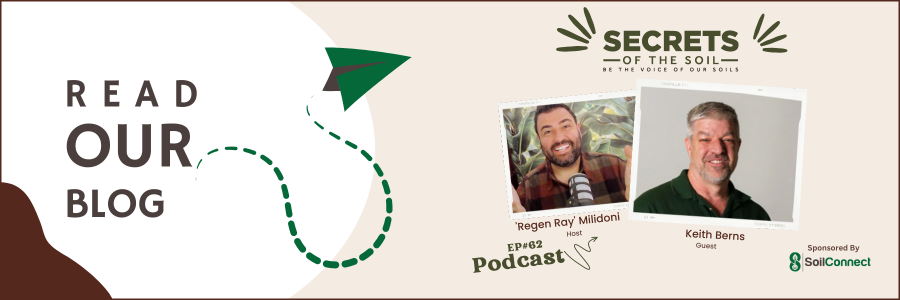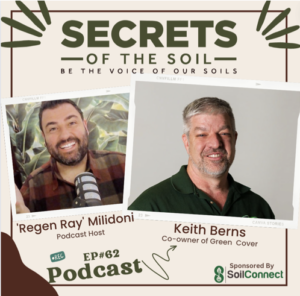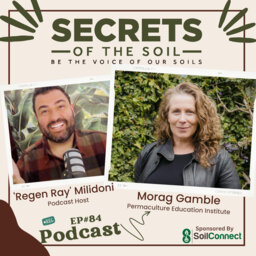🚜🌱 Excited to share the latest episode of “Secrets of the Soil” podcast! In Episode 62, host ‘Regen Ray’ Milidoni dives deep with Keith Berns from Green Cover Seeds on maximizing soil health and yield through cover crops, grazing, and organic matter.
🎧 Grab your headphones and let’s dig into the wealth of knowledge Keith has to offer. From the role of diverse seed mixes in creating more resilient agricultural systems to the incredible benefits of mycorrhizal fungi, this episode is packed with essential information for anyone passionate about soil health.
3 Key Takeaways:
🔍 Understanding Soil Health: The importance of cover crops in soil rotation, particularly how green plants provide carbon through photosynthesis and build organic matter via root exudates.
🌾 Cost Savings with Regenerative Practices: The case study of Farmer Rick showcases significant cost savings (up to 80%) by transitioning to no-till organic farming, eliminating synthetic inputs.
🌿 Mycorrhizal Fungi and Plant Cooperation: Diverse systems reduce competition among plants by leveraging unique nutrient and moisture requirements, facilitated by mycorrhizal fungi which aid in nutrient absorption, water retention, and plant communication.
Tune in to discover how Keith’s passion and expertise can help us nurture our soils for healthier, more sustainable agriculture. 🌍
Who is Keith Berns?
Keith Berns is an experienced no-till farmer and agriculture/computers teacher who co-owns and operates Green Cover Seed, a leading provider and educator of cover crop seeds in the US. With over 120 different cover crop types and hundreds of mixes planted, he has extensive knowledge on cover crop growth, nitrogen fixation, moisture usage, and grazing utilization. Keith was recognized as a 2016 Champion of Change for Sustainable and Climate-Smart Agriculture by the White House and developed the widely used SmartMix CalculatorTM for cover crop selection. He holds a Master’s Degree in Agricultural Education and teaches cover crops and soil health to various audiences more than 30 times per year. Keith was appointed by Nebraska Governor Pete Ricketts as the chairman of the Nebraska Healthy Soils Task Force.

In this week’s episode of *Secrets of the Soil*, we had the pleasure of diving into the transformative world of regenerative agriculture with Keith Berns. Keith, along with his brother, runs Green Cover Seeds in South Central Nebraska—a business born out of a passion for improving soil health through innovative practices like cover cropping and no-till farming. In our discussion, we unpack the mechanics of planting diverse seed mixes, the importance of soil data, and the connectedness of soil biology and human health.
Whether you are a seasoned farmer or just a soil enthusiast, this episode is filled with insights that can inspire and guide you towards healthier, more productive land.
The Mechanics of Diverse Seed Mixes
Keith Berns started by shedding light on the practice of planting diverse seed mixes. Unlike monoculture systems where uniformity is maintained, diverse mixes embrace chaos. This doesn’t mean it’s random or inefficient; it simply means different seeds don’t need to be evenly distributed. Various crops have different nutrient and moisture requirements, allowing them to coexist without fierce competition. This diversity mirrors natural ecosystems and promotes resilience within the agricultural system.
“The beauty of a diverse seed mix,” Berns explained, “is that it supports various plant expressions based on existing soil conditions.” Capturing and analyzing data on these conditions—thanks to people like Tom and Cassie, who are painstakingly collecting data on cover crops—helps farmers make informed decisions for future planting.
Cover Crops: The Heroes of Soil Health
When discussing cover crops, it’s crucial to understand their role in improving soil health. Cover crops like cereal rye are beneficial as they can be planted late, withstand cold temperatures, and continue to grow after the wheat harvest. They utilize the soil over an 11-month period, promoting nitrogen growth and providing supplemental forage for livestock. The long-term benefits are manifold: building organic matter, enhancing soil biology, and reducing reliance on synthetic inputs.
Keith shared success stories, notably Rick’s transition to no-till organic farming, which resulted in an 80% reduction in expenses. The financial and environmental benefits of such transitions underscore the potential of regenerative agricultural practices.
The Role of Mycorrhizal Fungi
A significant topic of our conversation centered around mycorrhizal fungi—microscopic organisms residing in plant roots. These fungi form an intricate network throughout the soil, assisting in nutrient absorption, water retention, and plant communication. However, modern farming practices, such as long fallow periods, excessive tillage, and overuse of fertilizers, can detrimentally impact these fungi.
“The interconnectedness of plants through mycorrhizal networks is a sign of a healthy ecosystem,” Berns pointed out. Therefore, nurturing these fungi is essential for soil health and productivity.
Education and Digital Resources for Soil Health
Education is pivotal in fostering an understanding of these regenerative practices. Keith Berns emphasizes the importance of learning through test plots, YouTube videos, and free downloadable resources available on the Green Cover Seeds website. The SmartMix calculator, in particular, is an excellent tool for designing custom cover crop mixes tailored to specific soil needs.
Keith also acknowledged the contributions of experts like Christine Jones, who distills complex agricultural concepts into simple, actionable insights. Additionally, he recommended a highly insightful 4-part webinar series by Rick Clark, offering practical advice and data for those on the regenerative journey.
Embracing a Regenerative Future
Transitioning to regenerative practices, as Keith illustrated, begins with incremental changes. He advises starting with annuals before transitioning to perennials—both providing quick wins and long-term benefits. Specifically, integrating cereal rye into corn and soybean rotations can yield positive results by enhancing soil structure and fertility.
Host ‘Regen Ray’ Milidoni encourages soil lovers to explore the world of soil firsthand and not shy away from getting their hands dirty. There is unparalleled value in firsthand experience and observation—essentially, becoming a student of the land.
This episode of Secrets of the Soil with Keith Berns was an inspiring delve into regenerative agriculture’s potential to revolutionize farming. Emphasizing education, data collection, and nature-inspired practices, Keith presented a compelling case for moving away from monocultures and synthetic inputs. By fostering diverse ecosystems within our soils, we pave the way for sustainable, resilient, and productive agricultural systems.
Remember to share this episode, leave a review, and subscribe for more insights into the secrets of the soil. For more resources, visit Green Cover Seeds and explore digital marketing support for soil-caring businesses at soilconnect.com.au.
Together, let’s nurture our soils and secure the future of farming.






